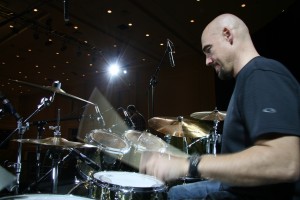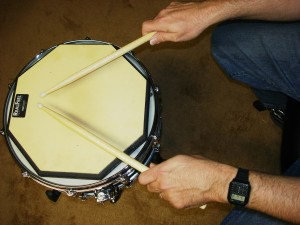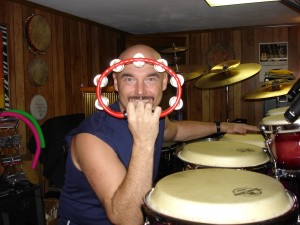
Carl warming up
The foundations of any instrumental performance are always crucial. Paul Baloche calls it the “blocking & tackling” of good musicianship… you HAVE to do some basic things to create a strong foundation in your playing. If you have had any formal training as a drummer you probably studied the 40 International Rudiments. I do recommend downloading the FREE pdf file from the Percussion Arts Society website. http://www.pas.org/Learn/Rudiments.aspx You should work on these to develop the drumming vocabulary you need to play almost any combination of ideas.
If you are just getting started with rudiments, or if you just want the “basics” of the basics I recommend this simple approach: Work on a simple combination of patterns that will create a strong foundation for the others. Because almost all music can be broken down into “duple” time ( which is subdividing or feeling everything in “2”)… or in “triple” time which is felt in “3”, you should practice basic sticking patterns counting with different subdivisions in mind. *For instance the “duple” time list goes like this:
Counting 1 e & ah 2 e & ah 3 e & ah 4 e & ah — play the following patterns/ repeating as many times as you like… I’d say at least 2 bars/ but 4 bars is better…. or until you feel you have it under control. – YES, USE A METRONOME – Start slow at first, and then everyday pick different tempo markings and learn to control the patterns at whatever speed you choose. **You may also play these on a practice pad if you like, but also be sure to have time playing the patterns around the drum set too.**
A Single Stroke Roll – R L R L R L R L R L R L R L R L,
a Double Stroke Roll – R R L L R R L L repeat….;
then a Paradiddle – R L R R L R L L repeat….;
then a few variations – R R L R L L R L …….. R L L L R L L L……. R R R L R R R L….. L R R R L R R R …… L L L R L L L R …… R R R R L L L L.
For the triplet feel you can count – 1 la lee 2 la lee 3 la lee 4 la lee, etc. etc. OR 1 trip let 2 trip let… OR even – tri-pa-let tri-pa-let & so on. Whatever counting method helps you focus on a triplet feel is fine. Now play these patterns:
A Single Stroke Roll — R L R L R L R L R L R L repeat….
A TRIPLE STROKE Roll — R R R L L L R R R L L L repeat….
A DOUBLE PARADIDDLE – R L R L R R L R L R L L ……
NEW – * A PARADIDLE-DIDDLE – R L R R L L R L R R L L / OR – start it left handed – L R L L R R L R L L R R
AND variations — R L L R L L……. R R L R R L……. L R R L R R ……. L L R L L R ……… R R R L L L …… *NEW – ALSO TRY playing doubles in a triplet count R R L L R R L L R R L L – You can count this as 1 & 2 & 3 & // or tri-pa-let tri-pa-let… etc.
ONE MORE NEW EXERCISE: Many of you asked how to get you kick drum involved in these patterns. You could have the feet play a constant groove as you play the hand patterns. **Simply walking on the main counts : kick on 1, hat on 2, kick on 3, hat on 4. OR… Kick drum on all 4 pulses (1/4 notes) ; hi-hat on 2 & 4. These are very common. Try any foot pattern you like, but start with these simple ones first.
Also try playing the sticking patterns with the kick drum as part of the pattern… Such as the “R’s” being your hands & the “L’s” being the kick. This is a great foot coordination exercise. Yes, you could use the hi-hat foot as part of the pattern, but let’s start with the kick for now. (As a hi-hat primer you could play constant 1/4 notes or 1/8 notes with your hi-hat foot as you play these hand & kick combinations. BUT, only do that after you’ve got the other parts working smoothly. / It’s OK to build one piece at a time.) OK… here we go…. **A very popular fill idea is to play 2 notes with the hands & 2 with the kick: R L k k R L k k — that’s right, left, kick, kick, etc. Count 1 e & ah, 2 e & ah, & so on. You can also start with the kick & finish with the hands, or any combination you like, but start with this basic stamina builder. YES, use a metronome. AND… lastly try playing a group of 6 notes… 4 with the hands 2 on the kick… R L R L k k R L R L k k. Be sure to count this pattern in a “3” pattern — 1 & 2 & 3 & OR “I like” — tri-pa-let tri-pa-let. OK,,, that’s plenty to build upon.
Of course you can play as many variations of the patterns as you choose, but I recommend starting with these. Also the classic drum book “Stick Control” by George Lawrence Stone is a great technique builder that would expand these ideas. But the idea of this post is to give you a vital starting point. Almost all other patterns will be built on these. OK… there ya go…. get to work and see how your control and stamina will grow. Be sure to count slow & steady at first. Then gradually build speed. Your goal is to keep it smooth and relaxed… NO TENSION!

Matched Grip













Recent Comments